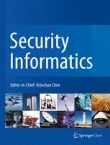Organised crime and social media: a system for detecting, corroborating and visualising weak signals of organised crime online
This paper describes an approach for detecting the presence or emergence of organised crime (OC) signals on social media. It shows how words and phrases, used by members of the public in social media posts, ca...
